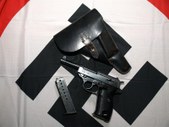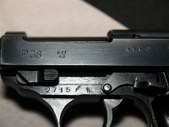
1
pistol, spare mag, and soft-shell holster
| 
2
slide serial number. Also note the early pattern extractor cut with the narrow milled slot at the back - this cut was eliminated on later production p38's.
| 
3
Left side view of pistol.
| 
4
Note the pattern around the screw escutcheon. In this case, six lines are interrupted by the screw - correct for byf (Mauser) and ac (Walther) made P38's. cyq (Spreewerke) guns have only 5 lines interrupted. This gun has black bakelite grips, late-war black grips were often made of a softer plastic. Both brown and black grips were used interchangeably on these pistols.
|

5
Note serial number below the barrel. Some 1943-vintage byf guns look to have been hand-filed in this area, while others were lathe turned. This example was hand-filed when assembled.
| 
6
Note the last 3 digits of the serial number and the suffix on the locking block. Oddly, it is not uncommon for different suffix letter fonts to appear on the pistols - it is likely these bits were serial numbers at different workstations during production.
| 
7
Another view of the barrel serial number. Again, note that the barrel was finished by hand. Some guns show rough lathe marks instead, though no patterns seems evident.
| 
8
Note the WaA 135 at the left and two firing proofs, one on the locking block and the other on the back edge of the barrel to the extreme right.
|

9
View of the chamber area of the barrel.
| 
10
View of the muzzle.
| 
11
View of the bore.
| 
12
Note the P38 marking on the back of this late-war holster. It is also marked jwa4 and bears no waffenampt, typical of late 1944 made holsters.
|

13
View of pistol frame with slide removed.
| 
14
Note the take-down latch is milled. On later guns, this was a hollow stamping.
| 
15
jwa 4 marking - jwa = Mortiz Stecher Lederwarenfabrik KG. The 4 represents 1944.
| 
16
Inside of holster flap. These softshell holsters are also sometimes referred to as "breakaway" holsters because of how they unfold.
|

17
View of pistol in holster.
| 
18
View of pistol and spare mag in the holster.
| 
19
Note the markings on the identical magazines, both made by jvd (Erste Nordböhmische Metall.w.f.), inspected by WaA708.
| 
20
Inspection and firing proofs on the slide, WaA135.
|

21
Slide and frame markings. note that the frame, slide and barrel (see earlier picture) all are stamped in different fonts. This is typical of mid-war Mauser P38 production and does not represent renumbering. byf43 = Mauser, 1943.
| |

